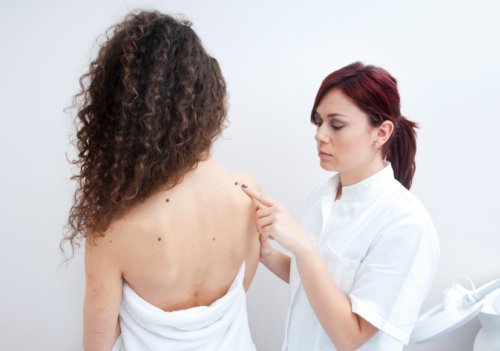 A “red mole”, also called a cherry angioma, is a small, bright red growth on the skin. Red moles tend to be circular in shape and can appear as raised mounds or blend in smooth and evenly with the skin.
A “red mole”, also called a cherry angioma, is a small, bright red growth on the skin. Red moles tend to be circular in shape and can appear as raised mounds or blend in smooth and evenly with the skin.
As the color suggests, if you scratch at or otherwise irritate a red mole, it is likely to bleed. This is because red moles are the result of an overgrowth of capillaries, a type of blood vessel.
There’s no known cause but genetics, chemical exposure, climate, and pregnancy are all suspected to play a role in how susceptible someone is to the condition.
Red moles pop up more in people over age 30 and can appear anywhere on the body, but most often emerge on the torso, arms, and shoulders. Roughly 70% of individuals over the age of 70 who have red moles have more than one.
Natural Ways to Remove a Red Mole
There are several natural remedies for red moles that can be tried at home; however, the effectiveness of these methods is still undetermined. The problem is that a red mole is not the result of inflammation, infection, or another form of disorder—it’s just an extra bunch of cells sitting around. Having said that, you may find some of the following remedies effective:
- Castor oil: In the morning, soak a cotton ball in castor oil and use tape to stick it on top of the mole. Remove it before you go to bed and then repeat each morning for seven days.
- Dandelion root: Cut the root of the dandelion and rub it over the red mole so it gets covered in as much of the milky juices as possible. Repeat two or three times per day for a week. If this treatment works, you will see the mole slowly detach and eventually fall off.
- Apple cider vinegar: Soak a bandage in an apple cider vinegar solution and apply it to the red mole each day for three weeks. Ideally this will cause the mole to shrink or fade.
Medical Options for Getting Rid of a Red Mole
Whether you call it a red mole or a cherry angioma, the condition is harmless. However, you may wish to get rid of your red mole for cosmetic reasons. Alternatively, the mole could be in a location that gets bumped easily and you’re tired of it bleeding all the time.
There are a few different medical options available when looking to eliminate a red mole. Talk to your doctor or a skin care expert about any of the following:
- Electrocauterization: This is a non-invasive surgery where a small probe is used to deliver an electrical current and burn off the mole.
- Cryosurgery: Similar to how it’s used for warts, cryosurgery will freeze the cherry angioma with liquid nitrogen and let the cold destroy the mass. This is a relatively quick procedure but not one that can be done with over-the-counter wart removers, so don’t try mixing products.
- Pulsed dye laser: Similar to electrocauterization, this approach seeks to burn off the red mole. It does so through the concentrated heat of a focused laser beam. The number of treatments depends on the number of moles being removed; there is a chance you can develop some bruising for a few days.
- Shave excision: This is a slightly more technical way of saying “slice at it with a cheese grater”. A doctor will slice away the red mole in thin layers until it vanishes. In some cases, a direct excision will be used where the red mole is simply cut out of the body. Such procedures are not as common due to development in treatment options.
How to Tell If a Red Mole Is Dangerous
A red mole, like all moles, is essentially a small overgrowth of tissue and is uncomfortably similar to a tumor. For the overwhelming majority of people, their red moles are little to be concerned about, but there is always that one person who gets the short straw. When examining a mole, keep the following in mind:
- Asymmetrical: Moles are normally roughly symmetrical in shape. Take notice if one is oddly arranged.
- Border: Even if it blends with the skin, a red mole should have a clearly defined border. Be aware if it seems to “fade off” or otherwise not have a distinct end point.
- Color: Moles are collections of a single type of tissue and should only be a single color.
- Diameter: A blemish is only considered a mole if it is within a certain size. If the mole’s diameter is greater than one centimeter (0.4 inches), you may have a problem.
- Evolving: Moles, as a rule, do not change once they appear. If your mole is growing, or has a change in color, then seek medical attention.
Should you notice any of the above, it is highly advisable that you talk to your doctor as soon as possible. Your doctor will be able to perform the necessary biopsies or other tests that can determine if the red mole is cancerous or not.
You should also consult a doctor if the red mole appears to be bleeding more than normal, as this could also be a sign of an underlying problem.
Read More :
Sources for Today’s Article:
Delgado, A., “Cherry Angioma,” Healthline web site, July 17, 2012; http://www.healthline.com/health/cherry-angioma#Overview1.
Gray, M., “How To Remove Red Moles,” Onehowto.com; http://health.onehowto.com/article/how-to-remove-red-moles-2262.html, last accessed December 1, 2015.
